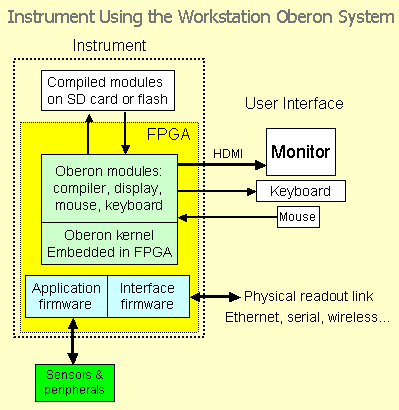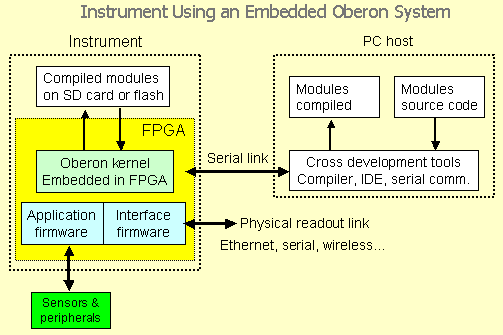Our Goal: Efficient Architecture of the FPGA-Based Instruments
Synopsis. We aim at creation of programmable instruments for science and education. The instruments will use Field Programmable Gate Arrays (FPGA) running a real time FPGA Oberon Operating System with the help of an embedded soft processor core named RISC5. (It motivated the name of this website.) Other soft cores running some other software are of course possible, but we will mostly focus on Oberon.
Background information. The single user workstation Oberon System was originally developed in mid 1980's. A new edition of this OS released in 2013 is running on the soft processor core which takes only 4% of logic resources in the Spartan-6 XC6SLX150. The entire operating system, including a compiler, run time library, and graphical GUI, can run in a single megabyte of RAM. The system without the GUI can run inside the FPGA, without using external RAM. The combination of the small processor core, efficient run time library, and modest memory requirements, will help to develop instruments using inexpensive mid-range FPGA chips.
Why are we using FPGAs, anyway? There are three main reasons we are using the FPGAs in our instruments.
- The embedded FPGA can be configured after manufacturing. It lets us update the firmware, fix bugs, or add entirely new features to already deployed instruments. Such flexibility is beneficial in scientific applications.
- The FPGAs support pipelined data processing, where many data items are processed in parallel. In some applications the performance of pipelined processing exceeds the performance of conventional processors by a large margin.
- Oberon firmware and software can be integrated with custom Application Firmware inside the FPGA. Combination of the general purpose Oberon computer with the special purpose application firmware results in a very powerful architecture, where parts of data processing is performed by the pipelined firmware, while another part is performed with software which is easy to customize.
There are two major variants of the FPGA Oberon System. The Workstation Oberon System comprises the solid state disk (i.e., the SD card), mouse, keyboard, and video monitor display. Other components can be present as well, such as Ethernet or wireless. The workstation software comprises the compiler, loader, run time system, device drivers, and the graphical user interface. In this configuration, the instrument becomes the development system, providing for extremely rapid development of one-off scientific applications.

The Embedded Oberon System cannot be used for self development because it lacks the video, mouse, keyboard, and the on board compiler. Software is rather cross - developed on a PC, and then downloaded to the target board. The embedded Oberon System can run in kilobytes rather than megabytes, using the on-chip Block RAM (BRAM) for execution. Other components can be present as well, such as Ethernet or wireless. In this configuration, the instrument becomes the development target, providing for deeply embedded data processing or control of any kind.

- The Main Features.
- The FPGA Oberon System runs on a soft core inside the FPGA.
- Thanks to efficient firmware and software, the instrument can use an inexpensive mid-range FPGA.
- Under the Workstation Oberon System, the instrument is also the development system.
- Under the Embedded Oberon System, the instrument is the cross - development target.
- The processing power and efficiency comes from integration of the Oberon Firmware with custom Application Firmware inside the same FPGA.
Other pages of this website describe the RiskFive project in great detail.
- Status.
- Thus far we developed three versions of the FPGA boards related to Oberon.
- Open hardware RiskZero is a minimal workstation board with Spartan-6 LX9 and two ZBT RAM chips. We do not plan to pursue this board beyond releasing the design for reference, because we have designed a much more powerful RiskOne.
- RiskOne is a small data acquisition (DAQ) workstation board with Spartan-6 LX25. It can interface to sensors and actuators using the daughter card connector and three PMOD connectors. This board is meant for development, education, light duty measurements, or control applications. We built two prototypes. Releasing this board is on hold till we find personnel to work on this project.
- A more powerful RiskFive is a daughter card with a Artix-7 A35. It can implement a fast speed data collection in a powerful scientific instrument.
Contact us for more info
Updated Sept/05/2023.
© 2020-2023 by SkuTek.com.


